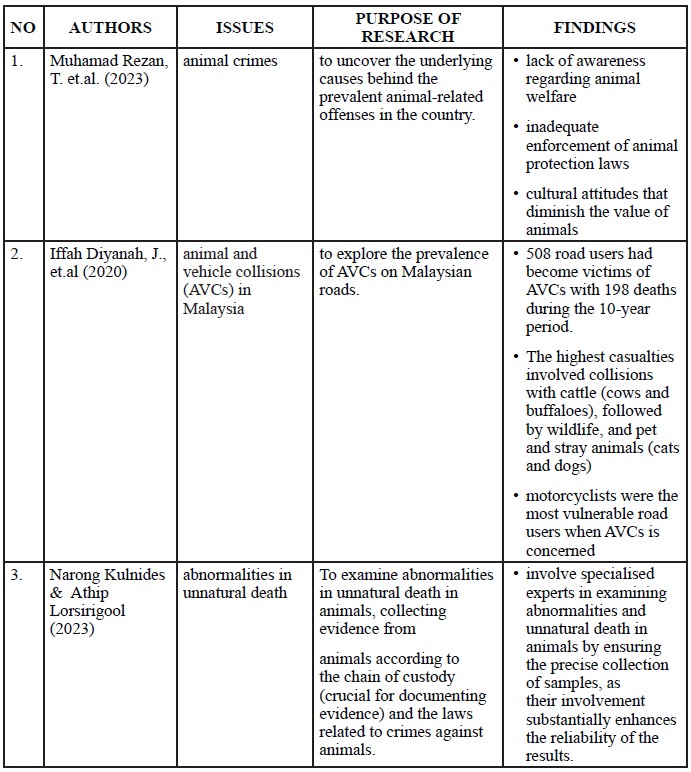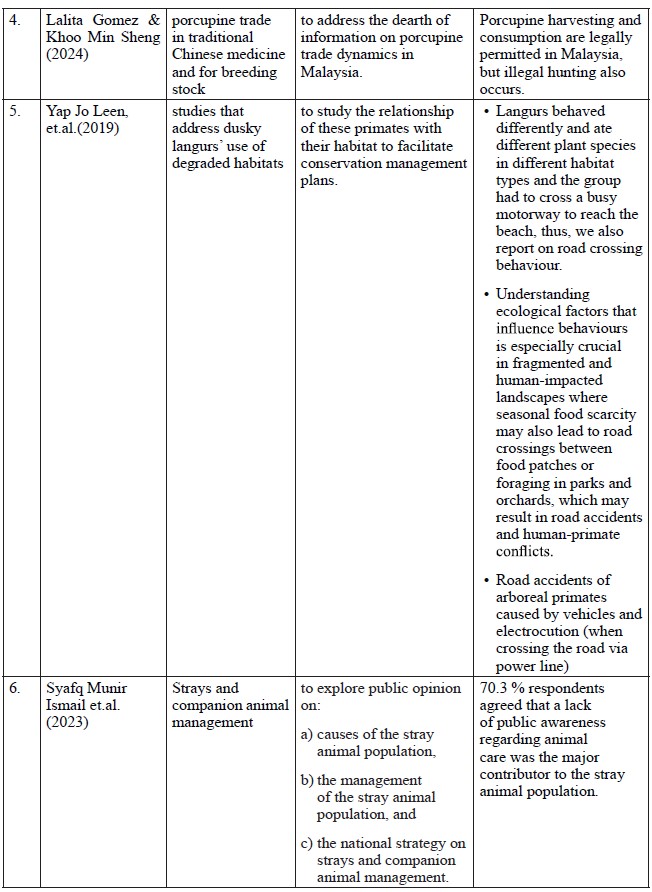
Executive Summary
- Rising cases of animal abuse in Malaysia, including Penang, underscore the need for urgent
interventions to protect animal welfare. - Causes of cruelty include lack of empathy, societal attitudes, inadequate legal enforcement,
psychological issues in perpetrators, and negative impacts of stray animal populations.
Malaysian laws on animal protection are poorly enforced, with insufficient training for law
enforcement and weak penalties under the Penal Code instead of the Animal Welfare Act
2015. - The ASEAN Cosmetic Directive allows animal testing, posing ethical and scientific issues,
and highlighting the need for regulatory reforms to ensure humane practices.
Recommendations include public awareness campaigns, enhanced legal frameworks, better
enforcement, community engagement, and strategies to reduce animal-vehicle collisions
and promote wildlife conservation as well as specialised training for veterinarians in
forensic science to prosecute cruelty cases.
Understanding Animal Cruelty: Causes and Prevention
Animal cruelty is a widespread issue that includes various forms of abuse, neglect, and exploitation.
From domestic pets to wildlife, animals often suffer at the hands of humans due to numerous factors.
In Penang, cases of animal cruelty involving cats and dogs have been on the rise, with 253 dog abuse
cases and 134 cat abuse cases reported in 2021 . The most recent incident occurred in February 2024,
when a hawker was jailed for one day and fined RM12,000 after being caught on video dragging a
female brown mongrel on the road using a 182 cm chain while riding his motorcycle last November2.
In an 2023 incident, three suspects—a cargo agent, a fisherman, and a bus driver—were detained and
face charges under the Animal Welfare Act 2015 after a dog was bludgeoned to death3.
In Malaysia, Animal Welfare Act 2015 was created to reduce animal abuse. This legislation outlines
the rights of animals, ensuring they receive appropriate shelter, care, and sufficient food,
whether they are companion animals, wildlife, or farm animals. The Department of Veterinary
Services isresponsible for enforcing this law and investigating matters related to animal
welfare. The act also prohibits practices such as animal fighting and mutilation.
Despite the implementation of the Animal Welfare Act 2015, animal-related crimes persist, with
many incidents going unreported. Perpetrators of such cruelty often operate under the misguided
belief that animals lack emotions and are therefore insignificant. Such behaviour should not be
allowed to continue, as it leads to serious injury, death, and, most tragically, the potential
extinction of a species. It is crucial to address and prevent such behaviour before it becomes
ingrained as a socially-acceptable habit.
This study investigates the root causes of animal crimes in Malaysia through comprehensive
secondary data collected through literature review. There is limited information available regarding
crimes against animals and the measures taken by Malaysia in these cases. The findings will provide
valuable insights for authorities, such as the Department of Veterinary Services and the Wildlife
Department, to develop and implement effective policies for addressing and preventing these issues.
The Root Causes of Animal Cruelty
Animal cruelty stems from several root causes, primarily a lack of empathy and respect for other
living beings. People often see animals as mere objects devoid of emotions and rights, leading to their
mistreatment. This lack of empathy can manifest in various forms, including physical abuse, neglect,
and abandonment. Societal attitudes and cultural norms may also perpetuate the notion that animals
are disposable commodities rather than sentient beings deserving of compassion and protection. This
perception is further reinforced by systemic issues such as industrial animal farming, which places
animals outside the sphere of justice, exposing them to various forms of abuse for the benefit of
humans, and normalizing animal suffering.
Additionally, psychological issues in perpetrators contribute to animal cruelty. Research suggests that
individuals who abuse animals often exhibit traits such as aggression, impulsivity, and a lack of
remorse. In some cases, animal cruelty can be a precursor to more severe forms of violence, including
domestic abuse and homicide. Addressing these underlying psychological issues is crucial to the
protection of both animals and society at large.
Also, the presence of uncontrolled free-roaming dogs and cats is a significant problem for humans,
and this often exacerbates negative attitudes towards animals. Stray animals are frequently seen as a
nuisance and a threat to public health due to the spread of diseases and their impact on the
environment. People often overlook that stray animals themselves suffer from poor welfare and abuse,
and lack essential resources such as shelter, food, and water. In achieving a ‘truly sustainability city’
clearly involves ensuring the well-being of all living things living in that city, including animals.
This holistic approach aligns perfectly with the Penang 2030 vision of a “Family-Focused, Green, and
Smart State that inspires the nation”.
While all beings contribute to shaping urban environments, humans often resist cohabiting with
species perceived as competitors. Trees and plants, are more controllable and beneficial in contrast
with autonomous animals that challenge human socio-geographical orders. Successful urban design
requires moderating inter-species competition and decentring the human perspective4. Malaysian law
explicitly protects animals from cruelty and ensures humane treatment. However, the protection
afforded to stray animals under the current animal protection regime is inadequate, as evidenced by
the increasing number of reported cases since the Animal Welfare Act 2015 came into force5.
Evidence indicates that inadequate enforcement of animal protection laws leads to increased
violations. Furthermore, insufficient training for law enforcement impedes the proper investigation
and prosecution of these crimes. In Malaysia, offenders are frequently charged under the Penal Code
rather than the Animal Welfare Act, resulting in less severe penalties and a higher likelihood of
repeat offenses.
Similarly, approximately 115 million animals are used in research experiments worldwide each year.
In ASEAN countries like Singapore, Indonesia and Malaysia, animal testing for cosmetics is currently
allowed. A significant gap in the ASEAN Cosmetic Directive (ACD) is the lack of a prohibition on
animal testing, which raises ethical and scientific concerns6.
Animal-related Issues
The collection of studies below offers a broad examination of various animal-related issues in
Malaysia, highlighting distinct challenges and insights.



The various studies outlined in the table above reveal significant and multifaceted issues regarding
animal welfare and animal-human interactions in Malaysia. These issues span a wide range of areas,
including animal crimes such as the frequent but undocumented trading of porcupines in Asia, vehicle
collisions involving animals, stray animal management, and the absence of a prohibition on animal
testing.
For instance, a study of the causal factors of animal crimes by Muhamad Rezan, Ain-Maryam, and
Adam (2023) addresses the underlying causes of animal-related offenses in Malaysia7. The primary
factors identified include a lack of awareness regarding animal welfare, inadequate enforcement of
animal protection laws, and cultural attitudes that diminish the value of animals. This research is
essential for comprehending the structural problems that lead to animal-related crimes. It implies
that these transgressions might be lessened by strengthening legal frameworks and enforcement, as
well as raising awareness of animal rights and welfare. To support its claims, the study may,
however, use more precise statistical data and specific case studies.
Another study based on news analysis by Iffah Diyanah, Yusof, Ahmad Khushairy, Mohd Hafzi &
Zulhaidi (2020) focuses on the prevalence and dangers of animal-vehicle collisions (AVCs) in
Malaysia. Their analysis reveals a significant number of casualties, particularly involving
motorcyclists, with the highest collisions involving cattles. In order to safeguard both road
users and animals, the study emphasises the necessity of improved road safety regulations and
awareness campaigns. While the data is compelling, further research could explore mitigation
strategies, such as improved road signage and fencing in high-risk areas8.
Meanwhile, Narong and Athip (2023) discuss the importance of veterinarians in forensic science,
especially in cases of unnatural animal deaths. Their review emphasises the role of veterinarians
in the precise collection of evidence, which is crucial for legal proceedings. This study
underscores the necessity of specialised training for veterinarians in forensic procedures.
Training might be improved by adding case studies or instances of effective forensic
investigations involving veterinarians9.
In a recent study, Lalita and Khoo (2024) explore the porcupine trade in Malaysia, focusing on both
the legal and illegal aspects of harvesting porcupines for traditional medicine and breeding. The
study highlights significant conservation concerns, particularly given the commercial value placed
on porcupines. The authors emphasise the need for stricter regulations and enforcement to combat
illegal hunting. While the study provides valuable insights into the conservation challenges
facing porcupines, it could have been further strengthened by a broader investigation into the
socio-economic drivers of the trade and the development of potential conservation strategies
that balance local traditions with wildlife protection10.
Research aimed at supporting wildlife conservation has found that restoring autonomy in ecological
systems effectively enhances resilience and facilitates restoration . In Penang, a study was
conducted by Yap, Nadine and Nik Fadzly (2019) on the behaviour and habitat use of Dusky Langurs
to inform conservation efforts. The langurs exhibited different behaviours and diets across habitat
types and had to cross a busy motorway to reach the beach. Understanding the ecological factors
influencing their behaviour is crucial, especially in fragmented and human-impacted landscapes.
Seasonal food scarcity can lead to road crossings between food patches or foraging in parks and
orchards, resulting in road accidents and human-primate conflicts. These accidents often involve
arboreal primates being hit by vehicles or electrocuted when crossing via power lines12.
Apart from Dusky langurs, Penang also face a stray population and companion animal management
issue. Syafq Munir, Mohd Istajib and Ahmad (2023) explored public opinion on the stray animal
population in Malaysia, finding that 70.3% of respondents attribute the issue to a lack of public
awareness regarding animal care13. Similarly, Dorothy, Khoo, Ho, Navanithakumar, Faizah and
Mishrin, Anun and Quaza (2019) examined public preferences in Penang for managing free-roaming
dogs (FRDs). Although Trap-Neuter-Return (TNR) is practiced, 55% of the public do not favour it
and 43% doubt its effectiveness. Additionally, 70% disagree with Trap-and-Euthanize (TE) despite
recognising FRDs as a nuisance14. Both studies highlight significant public concern and conflicting
views on stray management strategies. Asmida, Putri Syaidatul Akma, Amir Nur Ikhwan, and Nur
Fazini Asro (2021) found that the protection received by stray animals under the current animal
protection regime is inadequate. There is a lack of clear guidelines in enforcement concerning stray
animals, resulting in their welfare receiving insufficient protection. They suggest that an evaluative
study from a legal perspective on the protection of the welfare of stray animals is imperative15.
Meanwhile, in the context of animal testing on cosmetic products, The ASEAN Cosmetic Directive
(ACD) implemented by Indonesia, Malaysia and Singapore aims to harmonise cosmetic product
regulations. In industries where economic factors play a significant role, like cosmetics or animal
farming, profit often takes precedence over animal welfare. Animals raised for food or used in
experiments are subjected to overcrowded and unsanitary conditions, deprived of natural behaviours,
and exposed to painful procedures without adequate anaesthesia. The demand for cheap meat, dairy,
and consumer products fuels these cruel practices. According to Zulaila Aini and Idanawati (2023), in
ASEAN countries like Malaysia and Indonesia, animal testing for cosmetics is currently allowed due
to the absence of specific legislation regulating it. This situation raises significant ethical and
scientific concerns. Despite the use of animals like rodents and rabbits for safety evaluations, the
absence of an animal testing prohibition in the ACD leaves a notable regulatory gap, highlighting the
need for alternative methods to ensure both compliance and humane practices16.
Where is the Justice for Animal Abuse?
Human communities increasingly value ecosystems and are restoring them in cities. However,
attitudes of human superiority hinder progress on this front17. Beyond improving human lives, how
can we enhance the well-being of trees, birds, and other beings in increasingly degrading
environments? Just as companion animals like dogs and cats are known to have positive impacts on
human mental health and well-being—especially for those who are socially isolated or struggling with
adversity, such as the loss of loved ones—we should extend our care to all forms of life. Below are
recommendations to combat animal crimes in Malaysia, emphasising the notion of a
more-than-human community:
Recommendations to Combat Animal Crimes in Malaysia
Enhance Public Awareness:
• Implement nationwide awareness campaigns to educate the public on animal welfare and rights.
Effective management of stray populations through humane methods can mitigate this issue and
foster a more positive relationship between humans and animals.
• Integrate animal welfare education into school curricula to foster a culture of respect
and care for animals from a young age. Teaching empathy and compassion towards animals from a
young agecan foster a culture of respect and kindness. Schools, community organisations,
and government agencies can implement educational programmes that highlight animal welfare
and the ethical treatment of animals.
• Address underlying psychological issues through intervention and rehabilitation programmes to
help prevent recidivism and protect both animals and society at large.
• Pet owners should always be reminded of their responsibilities. Pets need more than just water,
food, and adequate shelter. They also need vaccinations and should be spayed or neutered to
reduce incidences of abandonment and abuse. Pet abandonment should be viewed as a serious
offense.
• Authorities must regulate pet shops to ensure that animals are provided with adequate space in
their enclosures. Each animal must have enough room in which to stand up, turn around, and
move comfortably. Additionally, strict hygiene standards must be enforced to ensure the
well-being and health of the animals. Penalties should be imposed on pet shops that fail to comply
with these regulations.
Strengthen Legal Frameworks and Enforcement:
• Update and tighten animal protection laws to ensure they are comprehensive and punitive enough
to deter offenders. Governments must enact and enforce comprehensive animal protection laws
that outline clear standards of care and impose strict penalties for offenders. Animal cruelty laws
should cover all aspects of animal welfare, including companion animals, livestock, wildlife, and
animals used in entertainment and research.
• Increase funding and resources for law enforcement agencies to improve the monitoring and
enforcement of animal protection laws.
• Establish a specialised unit within the police force dedicated to investigating and prosecuting
animal-related crimes.
Cultural Attitudes and Community Engagement:
• Work with community leaders and cultural influencers to shift attitudes that devalue animals.
• Promote community engagement programmes that encourage local participation in animal
welfare activities, such as adoption drives and humane education workshops.
• Mitigate Animal and Vehicle Collisions (AVCs) through the following recommendations:
– Install more effective road signs and barriers in areas prone to AVCs.
– Implement animal crossing structures, such as canopy bridges, underpasses and
overpasses, especially in areas with high wildlife traffic
Raise Driver Awareness and Education:
• Launch public service announcements and educational programmes informing drivers about the
risks of AVCs and how to avoid them.
• Include animal collision prevention training in driver education programmes.
• Develop a centralised database to track AVC incidents, which can help in identifying hotspots
and devising targeted interventions.
• Conduct further research on effective measures to prevent AVCs and protect both animals and
road users.
Recommendations for Veterinarians in Forensic Science
Specialised Training and Education:
• Provide specialised training programmes for veterinarians in forensic science, focusing on the
collection and preservation of evidence in cases of animal cruelty and unnatural deaths.
• Develop certification courses in veterinary forensics to ensure a high standard of practice.
Interdisciplinary Collaboration:
• Foster collaboration between veterinarians, law enforcement, and legal professionals to enhance
the effectiveness of investigations and prosecutions in animal cruelty cases.
• Establish a network of forensic experts who can be called upon to assist in investigations across
the country.
Policy and Legislative Support:
• Advocate for policies that support the integration of veterinary forensics into the legal system.
• Ensure that veterinarians have the legal authority and protection to collect and present forensic
evidence in court.
Recommendations for Promoting Mental Health Through Human-Animal Interaction
Integrate Pets into Mental Health Programmes:
• Develop programmes that incorporate pets into mental health and wellbeing initiatives, especially
during times of crisis or social isolation.
• Partner with animal shelters to facilitate pet adoption and foster care programmes as part of
therapeutic interventions.
Public Awareness Campaigns:
• Raise awareness about the mental health benefits of pet ownership through public campaigns and
social media.
• Provide resources and support for individuals considering pet ownership, ensuring they
understand the responsibilities and benefits.
Recommendations for Wildlife Conservation and Combating Illegal Trade
Strengthen Legal Protections:
• Enhance laws and regulations regarding wildlife trade, making laws controlling the hunting and
trade of species like porcupines more stringent.
• Implement harsher penalties for those caught engaging in illegal wildlife trade to serve as a
deterrent.
Increase Enforcement and Surveillance:
• Increase the number of wildlife enforcement officers and provide them with adequate training and
resources.
• Utilise technology such as drones and surveillance cameras to monitor protected areas and track
illegal activities.
Community Engagement and Alternative Livelihoods:
• Engage local communities in conservation efforts, providing education about the importance of
wildlife protection.
• Develop alternative livelihood programmes for those who rely on wildlife trade for income,
reducing their dependence on illegal activities.
Public Awareness and Advocacy:
• Conduct public awareness campaigns about the ecological importance of wild-life species and the
consequences of illegal trade.
• Support ethical alternatives to industries that exploit animals are key to reducing animal
suffering. Consumers can make informed choices by opting for cruelty-free products and
supporting companies that adhere to humane practices. By choosing to spend their money on
ethical alternatives, individuals can drive demand for humane products and encourage businesses
to prioritise animal welfare.
Implementing these recommendations requires a coordinated effort between government agencies,
non-governmental organisations, community leaders, and the public. By addressing the root causes of
animal cruelty and implementing proactive prevention strategies, a more compassionate and humane
society can be created where animals are treated with the dignity and respect they deserve. As
Mahatma Gandhi wisely noted, “…the greatness of a nation and its moral progress can be judged by
the way its animals are treated”18.
References
The Star. Sharp rise in animal cruelty cases. (2023). The Star, 11 July. https://www.thestar.
com.my/news/nation/2023/07/11/sharp-rise-in-animal-cruelty-cases
Alexander,H., & Stanislav, R. (2023). Supplementary materials for chapter 5. Participatory design for
multispecies cohabitation: By trees, for birds, with humans in designing more-than-human smart
cities: Beyond sustainability, towards cohabitation. https://zenodo.org/records/8213430
Asmida, A., Putri Syaidatul Akma, M.A., Amir Nur Ikhwan, A., Nur Fazini Asro, R.S. (2021).
Enhancing legal protection of stray animal welfare through society intervention. Studies of Applied
Economics, Vol. 39-10. DOI: 10.25115/eea.v39i10.6016
Audrey, D. (2024). Hawker jailed one day, fined RM12,000 for abusing dog. New Straits Times,
February 29. https://www.nst.com.my/news/crime-courts/2024/02/1019276/hawker-jailed-one-day-f
ined-rm12000-abusing-dog
Dorothy K.S., Khoo C.K., Ho H.W., Navanithakumar B., Faizah H.M.S., Mishrin., M.I., Anun M. &
Quaza N.H.N. (2019). A study of public preferences of trap-neuter-release (TNR) and trap-euthanasia
(TE) programmes of free roaming dogs in Penang. Malaysian Journal of Veterinary Research, 10(2):
113-124
Iffah Diyanah J., Yusof G., Ahmad Khushairy M., Mohd Hafzi M.I., & Zulhaidi M.J. (2020). A study
on animal and vehicle collisions in Malaysia based on news analysis. International Journal of Road
Safety, 1(2): 63-69.
Lalita G., & Khoo, M.S. (2024). The Trade of Porcupines in Malaysia with International Trade Links.
Tropical Conservation Science, Vol. 17 Lauricella, S. (2013). Judging by the way animals are treated:
Gandhi as a manifestation of Patanjali’s Yoga Sutras. Gandhi Marg Quarterly, 35(4): 655–674.
Lauricella, S. (2013). Judging by the way animals are treated: Gandhi as a manifestation of Patanjali’s
Yoga Sutras. Gandhi Marg Quarterly, 35(4): 655–674.
Mancini, C; Metcalfe, D., & Hirsch-Matsioulas, O. (2024). Justice by Design: The case for equitable
and inclusive Smart Cities for animal dwellers. In: Heitlinger, S; Foth, M., & Clarke, R. eds.
Designing more-than-Human Smart Cities: Beyond Sustainability, Towards Cohabitation. Oxford
University Press (In Press).
Muhamad Rezan T., Ain-Maryam, Z., & Adam, M.S. (2023). A Study of the Causal Factors of
Animal Crimes in Malaysia. Malaysian Journal of Social Sciences and Humanities, Vol 8 (8).
Narong Kulnides & Athip Lorsirigool. (2023). The role of veterinarians in forensic science: A review.
World’s Veterinary Journal World Vet J, 13(3): 452-458.
Syafq Munir I. M., Mohd Istajib, M., & Ahmad F. A. (2023). Public perspectives on strays and
companion animal management in Malaysia. BMC Public Health, 23:1428. 1-21
https://doi.org/10.1186/s12889-023 16276-5
Trisha, N. (2023). Three held for bludgeoning dog to death. The Star, 10 July,
https://www.thestar.com.my/news/nation/2023/07/10/three-held-for-bludgeoning-dog-to-death
Yap J. L, Nadine R., & Nik Fadzly N. R. (2019). Activities, habitat use and diet of wild dusky langurs,
(trachypithecus obscurus) in different habitat types in Penang, Malaysia. Journal of Sustainability
Science and Management, 14 (4): 71-85.
Zulaila Aini Z., & Idanawati, N. (2023). Current state of animal testing on cosmetic products in
Indonesia, Malaysia and Singapore. International Journal of Pharmaceuticals, Nutraceuticals and
Cosmetic Science, 6(2): 41-54.
You might also like:
![Cold War 2.0 Comes Knocking at ASEAN’s Door: Choices for ASEAN, China, and US]()
Cold War 2.0 Comes Knocking at ASEAN’s Door: Choices for ASEAN, China, and US
![ESG Disclosures among Public-listed Companies Based in Penang]()
ESG Disclosures among Public-listed Companies Based in Penang
![Penang’s Next Economic Leap: Insights from Comparisons with Global Financial Centres in the Region]()
Penang’s Next Economic Leap: Insights from Comparisons with Global Financial Centres in the Region
![Urgent Need to Strengthen Malaysia’s Legal Framework Against AI-Driven Scams]()
Urgent Need to Strengthen Malaysia’s Legal Framework Against AI-Driven Scams
![Malaysia’s Northern States: Improving Competitive Advantages and Industrial Growth]()
Malaysia’s Northern States: Improving Competitive Advantages and Industrial Growth






